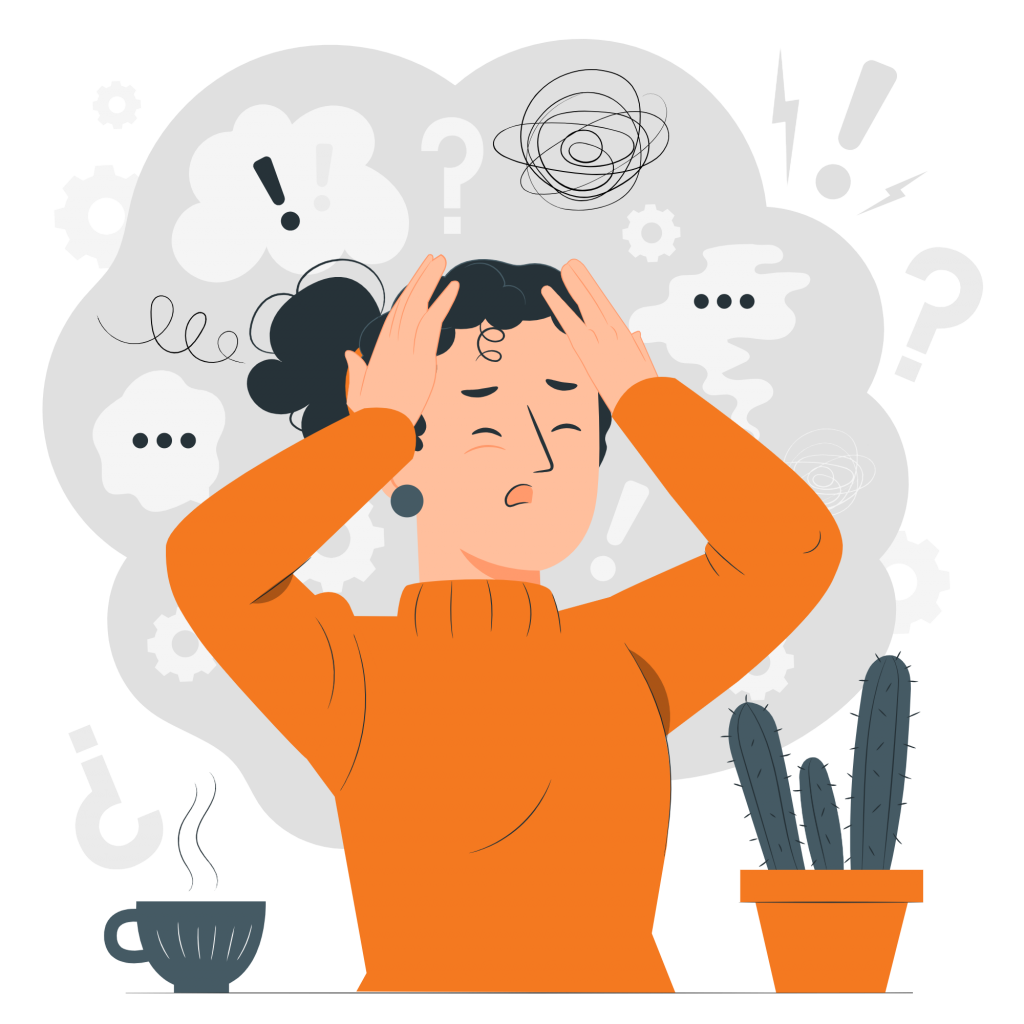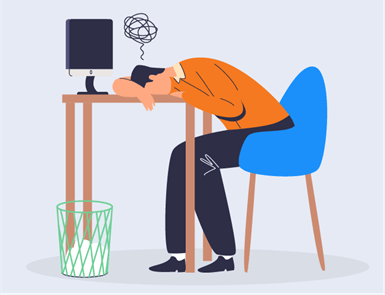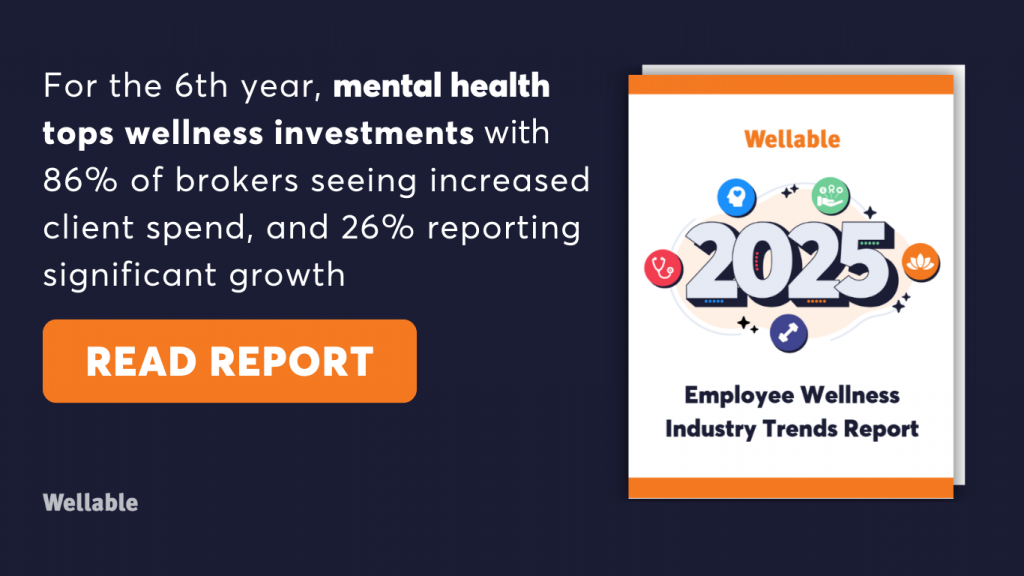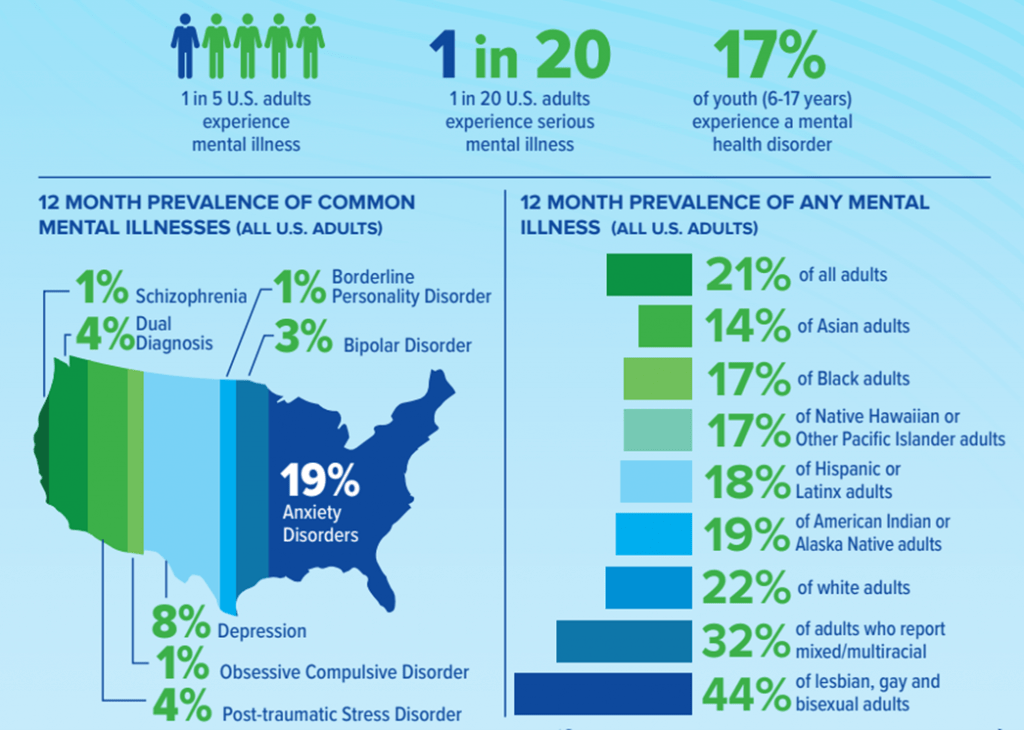COVID-19 hit the workplace like a storm, disrupting traditional organizational structures and exposing vulnerabilities in employee well-being. The World Health Organization (WHO) reported a worldwide increase in mental health problems in 2020, with cases of major depressive and anxiety disorders increasing by 27.6% and 25.6%, respectively. This trend spotlighted the urgent need for mental health support in the workplace.
People have shed their masks and returned to their beloved coffee shops, but mental health issues persist like lingering debris in the aftermath of the pandemic, keeping the focus on mental health front and center. One in five US adults experience loneliness daily, highlighting the persistent and evolving nature of such issues. Workers continue to demand mental health support, prompting employers to respond with benefits like flexible work arrangements, well-being programs, and access to professional help.
Despite these positive developments, some organizations have chosen a “check-the-box” approach to wellness, offering little in the way of meaningful support (known as well-being washing). To foster a resilient and productive workforce, employers must make continuous, authentic efforts to prioritize mental health.

What Is Mental Health?
“A state of well-being in which the individual realizes his or her own abilities, can cope with the normal stresses of life, can work productively and fruitfully, and is able to make a contribution to his or her community.”
WHO definition of Mental Health
Despite being a foundational pillar of well-being, mental health has been historically misunderstood, mistreated, and overlooked as a mainstream concern. Only in recent years has its importance been acknowledged, particularly in the workplace, as employees face challenges like increased workloads leading to anxiety, burnout from constant connectivity, and decreased productivity due to stress-related absenteeism.
There is no health without mental health.
WHO
Mental well-being enables individuals to navigate day-to-day challenges and thrive in all areas of life. Mental resilience also plays a pivotal role in overcoming difficult situations such as serious illness, grief, or loss.
The WHO strongly emphasizes that mental health is not simply the absence of a mental disorder. A comprehensive definition involves a multitude of factors, including aspects of emotional, psychological, and social well-being. There is no health without mental health.
Healthy mental function depends on the following:
- Ability to be self-aware
- Ability to self-reflect
- Ability to relate to others
- Ability to control impulses that interfere with rational behavior
- Ability to regulate emotions appropriately
Common Mental Health Disorders
A mental health disorder is a condition that affects a person’s thinking, feeling, behavior, or mood. These disorders can significantly impact daily functioning and well-being, often leading to challenges in relationships, work, and overall quality of life. The WHO identifies the following as the most common mental health disorders:
Anxiety Disorders

Anxiety disorders involve exaggerated feelings of fear and apprehension that occur unexpectedly and without warning. This includes generalized anxiety disorder, panic disorder and agoraphobia, obsessive-compulsive disorder (OCD), post-traumatic stress disorder (PTSD), social anxiety disorder, separation anxiety disorder, specific phobia, and health anxiety.
Mood Disorders
Mood disorders are a category of mental health conditions characterized by significant disturbances in a person’s emotional state, often leading to periods of intense sadness or elevated mood that interfere with daily functioning. People who experience depression, for example, may have difficulty sleeping, staying energized, concentrating, and managing their appetite. Some have thoughts about death or suicide.
Bipolar disorder is another mood disorder that causes extreme mood swings, energy, and activity levels. These changes can be severe enough to cause disability. There are two forms of bipolar disorder: bipolar I and bipolar II.
Schizophrenia

Schizophrenia is a mental illness characterized by hallucinations (hearing voices), delusions (false beliefs), and disorganized speech or behavior. The exact cause of schizophrenia is not fully understood, but it is believed to involve a combination of genetic, biological, environmental, and psychological factors. Research suggests that neurotransmitter imbalances, particularly involving dopamine and glutamate, play a significant role in the development of the disorder.
Post-Traumatic Stress Disorder (PTSD)
PTSD is a mental health illness caused by observing or experiencing a traumatic incident. Symptoms may include flashbacks, nightmares, and acute anxiety, as well as uncontrollable thoughts about the event. To be diagnosed with PTSD, symptoms must last more than a month and significantly impair social, occupational, or other important areas of functioning.
Eating Disorders
Eating disorders are characterized by abnormal eating habits that negatively impact physical and emotional well-being. These disorders can involve excessive focus on food, body weight, and shape, leading to severe disturbances in eating behaviors. Anorexia nervosa, bulimia nervosa, and binge-eating disorder are the most common eating disorders.
Mental health issues are more prevalent than many realize, and virtually everyone is susceptible to experiencing them. According to the National Alliance on Mental Illness (NAMI):
- 52.9 million US adults (21%) experience some form of mental health disorder every year. That’s more than the population of California, the most populous state in the US!
- 14.2 million US adults (5.6%) are living with a serious mental illness. That’s roughly equivalent to the population of Illinois, the sixth-largest state in the US!
- 17 million US adults (6.7%) experience a co-occurring substance use disorder and mental illness. That’s roughly equivalent to the population of Florida, the third most populous state in the US!
Common Work-Related Mental Health Challenges

Fifteen percent of working-age individuals have a mental disorder. Unfortunately, workplace environments can exacerbate mental health conditions or trigger new ones. Depression and anxiety alone account for 12 billion lost working days each year, leading to reduced productivity, increased absenteeism, and significant economic costs. Common work-related mental health stressors and their associated risks include the following:
Anxiety
Anxiety can be a silent struggle in the workplace, causing low morale, irritability, nervousness, and difficulties with concentration, which may lead to missed deadlines, lower productivity, and missed career opportunities. Beyond the mental strain, anxiety often produces physical symptoms such as fatigue, headaches, or disrupted sleep, compounding its impact on performance. If left unaddressed, anxiety can create a cycle of stress that affects the individual and reduces team cohesion and morale.
Burnout
Employee burnout can be insidious and lead to chronic exhaustion, disinterest, low morale, and decreased performance, harming an organization by reducing productivity and increasing staff turnover. Burnout is often characterized by three key features: emotional exhaustion, depersonalization/detachment from work, and a reduced sense of accomplishment. Together, these symptoms can undermine individual and team effectiveness.
Financial Stress

Financial insecurity occurs when a person lacks (or believes they lack) the money to pay bills and support basic needs. Chronic financial stress can lead to anxiety and decision fatigue. This has a detrimental impact on work participation, performance, and commitment, as employees struggle to balance work demands with their financial concerns.
Discrimination & Inequity
Despite increased efforts to promote diversity, equity, and inclusion (DEI) in the workplace, unwelcome conduct towards underrepresented groups, such as the LGBTQI+ community, persists. This aggression creates a hostile work environment with severe consequences, including increased stress, absenteeism, turnover, reduced productivity, and damaged morale. The emotional toll of discrimination can also result in long-term psychological effects, such as heightened anxiety, depression, and even PTSD.
7 Ways To Improve Employee Mental Health
Like any workplace issue, mental health challenges must be proactively addressed, mitigated, and supported through ongoing efforts. Employers should foster a culture of openness, provide accessible resources, and continuously evaluate their strategies to support employees’ emotional well-being.
1. Reduce Stigma Around Mental Health Disorders
According to a survey conducted by Mental Health America, more than 80% of respondents reported that work-related stress negatively impacted their relationships with friends, family, and coworkers. However, only 38% felt comfortable utilizing their company’s mental health resources.
Employers can provide mental well-being support, but these efforts are ineffective if the stigma around mental disorders persists. Employees who feel ashamed or afraid to discuss their mental health are less likely to access available resources. To reduce stigma, employers must encourage open communication and demonstrate acceptance toward those who are struggling. This involves:
- Regularly promoting mental health resources, such as in monthly publications (not just during open enrollment periods)
- Encouraging leaders and managers to openly share their experiences with mental health challenges
- Weaving mental well-being into regular conversations, such as performance reviews or one-on-one meetings, to normalize it within workplace dialogue
2. Normalize Mental Health As An Ongoing Journey

Leah Weiss is a teacher, researcher, and meditation expert specializing in the application of mindfulness and compassion at Stanford University. She’s also the acclaimed author of the book How We Work: Live Your Purpose, Reclaim Your Sanity, and Embrace the Daily Grind, which serves as a practical guide for individuals to bring their whole selves to work. Wellable reached out to Leah with an important question:
“How do you bypass the stigma surrounding mental health and create an environment where employees can step up and ask for help?”
This is her advice:
For some, mental health comes easily, while physical well-being is more challenging to maintain. For others, the opposite is true. This difference does not imply that anyone is superior or inferior; rather, it reflects the unique composition of each individual, with distinct strengths and weaknesses. Just as maintaining physical health requires continuous effort through nutrition, exercise, rest, and sleep, mental health also requires ongoing attention. It’s not something that can be “fixed” once and forgotten; it requires consistent care, reflection, and adjustment.
Addressing burnout, reducing stress, managing anxiety, dealing with depression, and coping with trauma are all parts of the human experience. Everyone encounters periods of thriving and moments of difficulty. Normalizing these cycles of flourishing and adversity can help employees to express their needs openly instead of feeling shame or social isolation.
3. Implement Employee Assistance Programs (EAPs)
Employee Assistance Programs are usually staffed with social workers, psychologists, psychiatrists, and other mental health experts. These well-trained professionals provide employees with a variety of confidential counseling services to assist them with their mental health needs.
Most EAPs have been overlooked and underutilized. However, these programs are gaining recognition as a valuable resource for handling mental health issues in the workplace. Nearly all companies (97%) offer some type of EAP; unfortunately, less than 5% of employees actively take advantage of this resource due to poor execution, persisting stigma surrounding mental health issues, and confidentiality concerns. Employers must take intentional steps to improve the visibility, accessibility, and trustworthiness of their EAPs by:
- Regularly promoting EAP services through multiple channels (e.g., newsletters, team meetings, onboarding sessions)
- Clearly communicating privacy protections
- Destigmatizing EAP use by sharing anonymized stories of employees who have benefitted from programs
4. Provide Mental Healthcare

On-site healthcare clinics are widely offered as an employee benefit. These resources can improve employees’ longevity and reduce absenteeism by providing immediate access to medical services. Employers can enhance mental health support by integrating mental health services into their pre-existing on-site clinics.
Telemedicine is a viable alternative or complementary option, allowing employees to access mental health professionals remotely. This provides them with the flexibility and convenience to attend consultations or therapy sessions without physical presence at a clinic. By offering both in-person and virtual support, employers can ensure their workforce has multiple pathways to access the care they need.
For those seeking more preventive support, health coaching is another valuable option. Health coaches work with individuals to address lifestyle factors that influence mental well-being, such as stress management, sleep, nutrition, and exercise. By focusing on prevention and lifestyle changes, health coaching can help employees build resilience and reduce the likelihood of developing more serious mental health issues.
5. Offer Stress Management Programs

Workplace stress is a catalyst for employee mental health issues. Organizations can implement stress management challenges and programs to support employees. Although these programs differ in composition, the main goal is consistent: to assist employees in coping with stress through education, group counseling, management techniques, virtual coaching, and mindfulness practices.
Organizations on a budget can recommend or offer free or low-cost mobile app solutions. One popular app is Headspace, which guides users through meditation and mindfulness sessions with lively animations and helpful information. Alternatively, employers can leverage Wellable’s On-Demand solution for employees seeking convenient ways to unwind and manage stress. Employers can also consider asking an existing employee with experience in meditation or mindfulness to lead a class on the topic.
6. Prioritize Work-Life Balance
A lack of boundaries between work and personal life can lead to burnout, increased stress, and reduced productivity. Employers can promote work-life balance by:
- Offering flexible work arrangements
- Implementing a holistic wellness program that supports all dimensions of well-being, including sleep, stress reduction, and nutrition
- Creating wellness rooms (e.g., meditation spaces)
- Encouraging employees to take advantage of their vacation time; some organizations accomplish this by limiting the amount of vacation time employees can carry over into the following year
- Making accommodations and creating a return-to-work process for those who need to take a leave of absence due to a mental health condition, ensuring they feel empowered and welcomed when they return.

7. Leverage Mental Health Resources And Education
For employers looking to expand their mental health initiatives or employees seeking additional support, the following trusted resources provide valuable information and tools.
Public Mental Health Resources
- Mental Health America (MHA) – MHA is the nation’s leading community-based nonprofit dedicated to meeting the needs of people living with mental illnesses and promoting general mental health.
- Center for Workplace Mental Health by American Psychological Association (APA) – APA provides companies with the tools, resources, and information they need to promote and support their employees’ and their families’ mental health.
- National Alliance on Mental Illness (NAMI) – NAMI advocates for, educates, supports, and raises public awareness about mental illness so all persons and families touched by it can lead better lives.
- Employer Assistance and Resource Network on Disability Inclusion (EARN) – EARN provides information and resources to assist employers of all sizes in recruiting, hiring, retaining, and advancing people with disabilities; developing inclusive workplace cultures; and meeting diversity, equity, inclusion, and accessibility (DEIA) goals.
- Substance Abuse and Mental Health Services Administration (SAMHSA) – SAMHSA is the agency under the United States Department of Health and Human Services coordinating public health efforts to improve the nation’s behavioral health.
- International Employee Assistance Professionals Association (EAPA) – EAPA is the most trusted source of information and support for and about the employee assistance profession.
More Mental Health Resources From Wellable
- On-Demand Webinar: Mental Health Essentials: Employee Support Under Stressful Conditions
- 5 Ways To Celebrate World Mental Health Day In The Workplace
- Employees (Still) Desperately Need More Mental Health Support
- 94% Of CEOs Think They Provide Adequate Mental Health Support, 67% Of Employees Agree
- The Wild West Of Mental Health Apps
- Multi-Purpose Mental Health Benefits Popular Among Employers In 2022
- Mental Health Conditions Remain Elevated As Pandemic Continues
- Employee Mental Health Continues To Plummet
- 8 Barriers To Wellness Program Participation
- Connecting The Dots Between Wellness and Mental Health
Mental Health Trends
Workers are more vocal about mental health now than ever before. Employers realize if they don’t address employees’ demands, other companies will—making it even more difficult to attract and retain top talent. Investing in mental health is a win-win for everyone, and companies that recognize this stand out in a competitive job market.

To stay ahead of the curb, consider these mental health and well-being trends:
- Mental healthcare is becoming a key component of workplace benefits, but there’s still a need for better communication and accessibility. Nearly one-third of employees are uncertain about the adequacy of the resources available to them, and one-quarter are unsure if their employer offers mental healthcare coverage at all. Employers must clearly and proactively communicate what mental health services are available to their workforce.
- The movement away from “hustle culture” will continue growing. After over a decade of hustle culture popularized during the golden Silicon Valley era, it’s no surprise that employee burnout has become increasingly common. The pandemic only intensified the need for work-life balance. While many work routines have returned to pre-pandemic standards, companies must continue prioritizing work-life balance and valuing individuals as people, not just the sum of their outputs.
- Early intervention is becoming a key strategy for fostering long-term well-being. More organizations are embracing preventive care to address potential challenges before they become larger issues. By implementing regular mental health check-ins, health coaching, and stress management sessions, employers are taking proactive steps to protect employee well-being and reduce the likelihood of more severe issues developing down the road.
- Tailored, technology-driven solutions are shaping the future of mental health strategies. Employers are leveraging AI tools to assess well-being, enhance access, and provide targeted recommendations. Personalized care ensures that employees receive timely, relevant support that addresses specific mental health challenges.
- Flexible work arrangements will remain standard. Remote, hybrid, and flexible work are here to stay, helping employees better manage the demands of their professional and personal lives. This sustainable way of working boosts well-being, job satisfaction, and retention. Some employers have experimented with compressed work weeks to improve work-life balance.
- Accommodation for working parents and support for their loved ones will be prioritized. The challenge of juggling remote work and childcare has created a demand for family-friendly benefits to support working parents. Businesses can also provide behavioral health benefits programs, which address a wide variety of mental health challenges for adolescents and teens.
Why Mental Well-Being Is Good For Business

While prioritizing employee mental health is intrinsically important, the benefits of fostering mental well-being in the workplace also make it a compelling business decision.
- Productivity: Unaddressed mental health disorders can result in a notable loss of productivity in the workplace in the form of presenteeism (being present at work but unengaged) or absenteeism. This is especially the case if employee stress stems from work-related matters.
- Medical expenses: Poor employee mental health results in high medical costs for the employer. One study found that employees who reported being depressed, unable to manage stress, or a combination of the two were 70%, 46%, and 147% costlier than employees who did not experience these risk factors, respectively.
- Retention: Mental health problems can contribute to high employee turnover. The major argument in support of building a healthy workplace is based on two ideas:
- Happy, healthy employees are more productive.
- Employees are more likely to experience higher job satisfaction and remain loyal to a company that is perceived to care for them.
Both strongly attest to why employers should prioritize mental health. Employees who do not feel supported in this area will seek companies that prioritize their needs.

- Morale: Poor mental health can deteriorate employee morale, which includes how they feel about their job, their team, and the organization. They may struggle to perform their jobs effectively if they are unable to escape a negative mindset and feel unsupported by their employer.
- Brand image: Employers that neglect mental health may tarnish their reputations by lacking social responsibility to their employees. Alternatively, organizations that prioritize workforce well-being boost their brand image and have a competitive edge in attracting top talent. Nearly 90% of employees working for companies with wellness programs report being happy and engaged with their job and would recommend it to a friend. Job seekers continue to pursue organizations that maintain a people-first reputation.
- Absenteeism: Burnout from stress, anxiety, and mood disorders can cause chronic absenteeism. Providing mental health support can maximize the productivity of the workforce.
- Team collaboration: When employees feel supported and cared for, they are more likely to develop a sense of belonging and trust within the organization. Enhancing employees’ social wellness facilitates open communication, the sharing of ideas, and effective problem-solving among team members.
Conclusion
Creating a safe and healthy workplace is a fundamental right of every worker and a wise business move. Prioritizing employee well-being comes with a host of benefits, from enhanced performance and productivity to decreased medical costs and absenteeism. When employers demonstrate a steadfast dedication to the well-being of their workforce, they create a positive, mutually beneficial work environment that employees are reluctant to leave.
Supporting mental health in the workplace is not optional — it’s necessary.
By providing ongoing resources and support for mental health, employers can help their employees thrive personally and professionally, leading to a healthier, happier, and more productive workforce.
This article was last updated on October 31, 2024.














